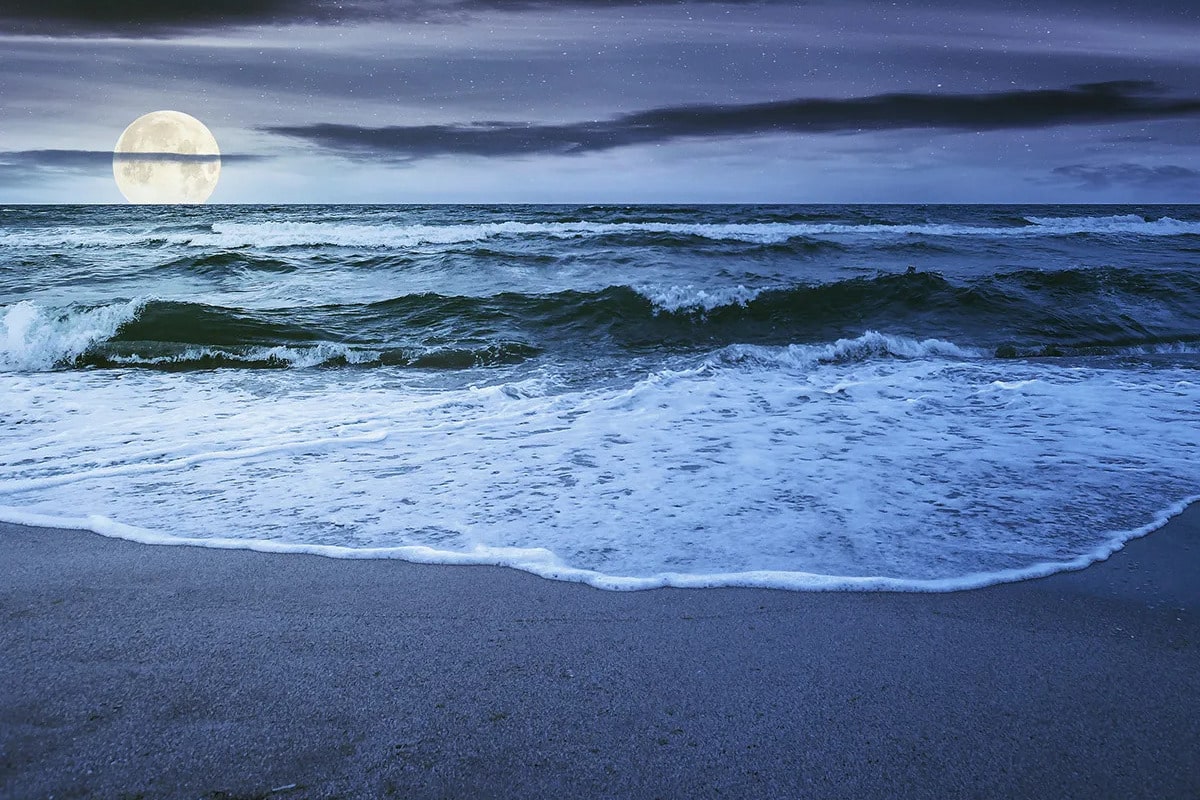In the world of nature, tides are as fascinating as storms, earthquakes, or volcanic eruptions. They occur daily, yet many people do not realize how complex and remarkable the processes behind these fluctuations in sea level truly are. Interesting facts about tides allow us to view them not merely as routine events but as impressive examples of the interaction between cosmic forces and the Earth’s hydrosphere. This selection includes incredible facts you may not have known before. They reveal how significantly tides influence life on our planet.
- Tides are primarily caused by the gravitational pull of the Moon on ocean water, with the Sun also playing a secondary role. The Moon’s gravity draws water toward it, creating a bulge on one side of the Earth, while centrifugal force causes a similar bulge on the opposite side. These opposing forces create a cycle of high and low tides that repeats approximately every 12 hours and 25 minutes. This cycle results from the Earth’s rotation and the Moon’s orbit.
- In most places on Earth, there are two high tides and two low tides each day, although their heights can vary. This pattern is called the semidiurnal tidal cycle. Some regions experience only one high and one low tide per day, known as the diurnal cycle. Others display a mixed pattern, with daily tidal behavior changing throughout the month.
- The highest tidal range in the world occurs in Canada’s Bay of Fundy. Here, the difference between high and low tide can reach up to 16 meters. This is one of the most dramatic examples of gravitational forces in action. Such extreme tides create unique environments for marine organisms.
- Tides have a major impact on coastal ecosystems, altering the living conditions for many plant and animal species. They determine when fish can enter estuaries and when seaweed becomes accessible for feeding birds. Without these regular changes in water levels, coastal life would be entirely different. The rhythm of tides regulates the behavior and survival of many organisms.
- During low tide in certain locations, people can walk across the seabed. For example, in France, the famous path to Mont-Saint-Michel becomes accessible only during low tide. Tourists can walk there on foot but must pay attention to the time, as the returning tide can be dangerous. In some places, the water rushes back as fast as a galloping horse.
- Some marine animals have adapted to life with frequent low tides. Mussels, crabs, and starfish can survive for hours out of water while waiting for the tide to return. Their biological processes are synchronized with tidal rhythms. This is a clear example of nature-driven adaptation.
- Tidal energy is harnessed by tidal power stations built in areas with strong and regular tides. These stations generate electricity using turbines that rotate as water flows in and out. Tidal energy is a clean alternative to fossil fuels. It is a promising solution for renewable energy in coastal regions.
- The strongest tides occur during full and new moons, when the Sun, Moon, and Earth align. This is known as a spring tide. During these events, high tides are higher, and low tides are lower than usual. The oceans are under enhanced gravitational influence during this alignment.
- Solar and lunar eclipses can also bring unusually strong tides. This results from the special alignment of celestial bodies and intensified gravitational effects. Such tides are predicted well in advance by astronomers. The information is essential for sailors, fishermen, and coastal safety services.
- Tides play a crucial role in navigation and port operations. In many ports, ships can only enter or leave during high tide. Tide schedules are carefully considered when planning shipping routes and loading times. Miscalculating tides can lead to delays and financial losses.
- In some cultures, tides have religious or mythological significance. Ancient civilizations associated tidal movements with the moods of gods or spirits of nature. In India, tides are sometimes viewed as signs of divine cycles. Japanese folklore connects tides with the spirits of the sea.
- Scientists use tide measurements to monitor climate change and rising sea levels. Long-term observations help detect gradual ocean rise. This is a key indicator of global warming. Tides also influence shoreline erosion and changes in coastal landscapes.
- In some parts of the world, tides create what are known as tidal bores. For instance, China’s Qiantang River experiences a tidal wave that flows upriver against the current. It can reach several meters in height and has enormous force. This rare and spectacular event attracts thousands of spectators.
- At low tide, the shoreline expands, revealing areas rich in marine life. This is the best time to collect shellfish, examine seaweed, or discover the remains of sea creatures. For biologists, low tide provides valuable opportunities for field research. It uncovers what is usually hidden beneath the water.
- In oceanography, tides are studied within the field of tidal dynamics. They are factored into models of ocean currents, storm forecasting, and coastal engineering. Without understanding tidal patterns, it is impossible to design safe and effective coastal infrastructure. Tides are also important in planning offshore energy and resource extraction.
- Some moons of other planets, such as Europa — a moon of Jupiter — may also experience tides. Scientists believe there is an ocean beneath Europa’s icy surface, influenced by Jupiter’s gravity. These gravitational interactions could cause water movement similar to Earth’s tides. This gives hope for the potential existence of life in extreme extraterrestrial environments.
Tides are not merely fluctuations in water levels but a complex and globally significant natural phenomenon. These fascinating facts about tides demonstrate how cosmic movements are deeply connected to daily life on Earth. From energy to ecology, from culture to science, tides influence many aspects of our world. Understanding them helps us appreciate the planet’s rhythms and manage its resources wisely.





